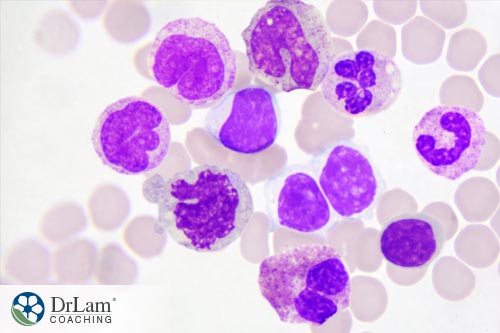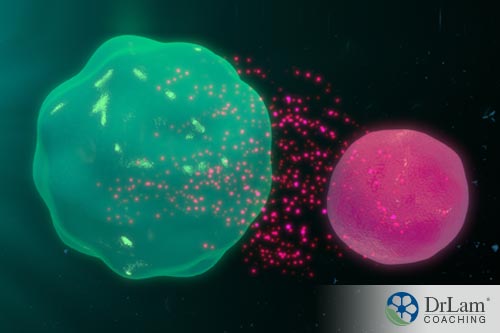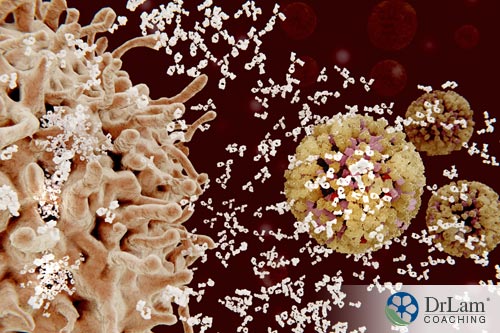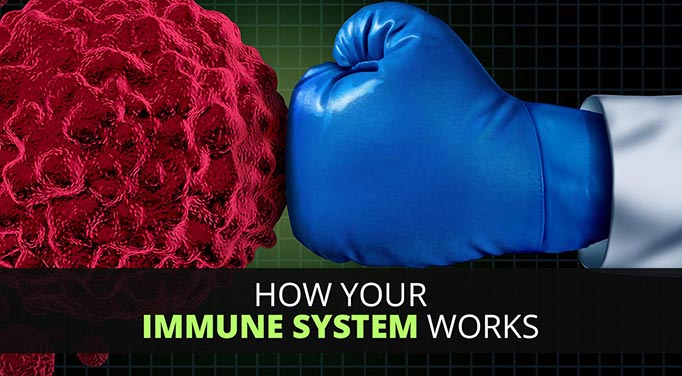 The immune system is your defense against pathogens, infections, tumors, and damage from injury. Its importance cannot be overstated, as those who take immunosuppressant drugs will tell you. Without a strong and healthy immune system, you get sick more often, your health issues last longer and create more damage, and your quality of life suffers for it. That’s why reversing immunosenescence – the deterioration of the immune system with aging – is one of the most vital emerging practices in regenerative medicine.
The immune system is your defense against pathogens, infections, tumors, and damage from injury. Its importance cannot be overstated, as those who take immunosuppressant drugs will tell you. Without a strong and healthy immune system, you get sick more often, your health issues last longer and create more damage, and your quality of life suffers for it. That’s why reversing immunosenescence – the deterioration of the immune system with aging – is one of the most vital emerging practices in regenerative medicine.
Strengthening and balancing your immune system, whatever condition it’s in right now, will give you some of the biggest returns on investments in your health that you can get, no matter your age. And implementing a few changes right now can help you in slowing down or even reversing immunosenescence, and that will protect your health later down the line.
Although medications and supplements that help in slowing down and reversing immunosenescence directly are being produced and tested right now, they are still very new in the market and most people do not have access to them yet. However, this article outlines some of the exciting results of studies conducted on them so you can be informed. In the meantime, we will discuss practical strategies that you can start now in order to strengthen your immune system and begin reversing immunosenescence.
Before getting into these strategies, as well as some precautions you need to be aware of before implementing them, you should first understand how the immune system functions and what factors are involved in its decline, whether naturally through aging or prematurely through exposure to different conditions.
Also, if you have Adrenal Fatigue Syndrome (AFS) or any kind of dysregulation of your NeuroEndoMetabolic (NEM) Stress Response, or if you suffer from any type of autoimmunity, you’ll need to pay extra attention to the precautions we outline regarding these strategies, and find ways to strengthen and balance your immune system without overloading your system with more stress.
The subject of autoimmunity is still important for you even if you do not have an autoimmune condition, since it is becoming a growing health concern in general, and since it is closely tied to some of the risk factors of other issues such as AFS, hormone imbalance, inflammation, stress, and aging – all of which have an effect on the immune system.
The immune system is truly a miracle of the human body, and understanding how it functions and what affects its functioning is knowledge that will serve you throughout your life. Understanding the immune system gives you great respect for your body, and it enables you to implement one of the most beneficial strategies for health, longevity, and wellbeing there is: prevention. Prevention is always better than cure, and even if you are currently working to manage other health conditions, you can still use prevention tactics to avoid any other health problems you may be at risk of developing in the future.
Your immune system is amazing. It protects you from invasions by pathogens and toxins. It also protects you from internal damage from tumors, cell debris, and oxidative stress. And what’s even more amazing is how it is organized, with different components responsible for different types of immunity.
Some of these different components hail from different periods of human biological evolution. Meaning, there are some aspects of your immune system that are much older than others, with newer aspects developing later on in order to fulfill new needs.
The first way we categorize the immune system is by the scope of its action: innate or specific immunity.
 Innate, or natural, immunity is the older immune system. It evolved very early on in our biological history. Its job is to protect you from external threats by producing phagocytic cells, like macrophages, that attack pathogens by engulfing them. One of its first responders – the first cells that travel to sites of infections - are the neutrophils, which are a type of white blood cell, a type of phagocyte, and a type of granulocyte (white blood cells that contain granules in their cytoplasm).
Innate, or natural, immunity is the older immune system. It evolved very early on in our biological history. Its job is to protect you from external threats by producing phagocytic cells, like macrophages, that attack pathogens by engulfing them. One of its first responders – the first cells that travel to sites of infections - are the neutrophils, which are a type of white blood cell, a type of phagocyte, and a type of granulocyte (white blood cells that contain granules in their cytoplasm).
Innate immunity also releases cytokines that stimulate the immune cells to move to the sites of injuries and infections, as well as natural killer cells (NKs) whose job is to kill infected cells or cancer cells.
Its response is very rapid and not very precise – it has more of a broad response than specific immunity. The other parameters that distinguish it from specific immunity are that it has no memory, meaning that once its job is done, it does not retain memory cells that stay in the system in order to recognize if the same pathogen (virus or bacteria) attacks again. Its immune cells have a short lifespan as well.
Specific, or adaptive, immunity is more specialized. It targets specific issues. It solves the problem of how to fight off the infinite array of pathogens that attack the human body without having to flood the system with white blood cells. Instead, it uses antibodies created by B cells, and cytokines created by T helper cells, as well as its own NKs.
Without specific immunity, your body would have to be composed of a huge quantity of white blood cells in order to keep up its defenses, and even then you’d still be much more vulnerable to infections. But adaptive immunity adapts to the antigen – the proteins found on the surface of pathogens – by creating antibodies specific to it.
That’s the brilliance of this newer part of the immune system: it has the ability to recognize a huge variety of antigens with great accuracy. It does this through a complex DNA arrangement that creates specific T cell receptors or B cell antibodies.
Specific immunity uses each type of lymphocyte with a specific focus on one antigen, but it needs to proliferate massive numbers to be able to destroy pathogens and tumors. As soon as the pathogen or tumor is gone, the lymphocytes apoptose –die through programmed cell death – in order to clear immunological space for the next round, and so your system is not filled with white blood cells. Memory cells are left behind in order to recognize when the same pathogen tries to attack the system again.
Unlike innate immunity, specific immunity is a delayed response. It evolved later, and as with many things in evolution, the later something evolved biologically, the more susceptible it usually is to problems, especially with age.
These two scopes of action – the innate and the specific immune responses – complement each other. Specific immunity is responsible for protecting your body the 5% of the time that the innate immune system isn’t sufficient.
The next two divisions the immune system can be categorized by are through its main areas of operation: cellular immunity or humoral immunity.
 Cellular immunity, which is sometimes called cell-mediated immunity, tags and gets rid of pathogens that are inside the cells. Not all pathogens are small enough to get inside cells. This type of immunity is primarily mediated by T cells, which are thymus-derived lymphocytes. The two types of T cells that go into action are T helper cells and T killer cells. Cellular immunity does not involve antibodies.
Cellular immunity, which is sometimes called cell-mediated immunity, tags and gets rid of pathogens that are inside the cells. Not all pathogens are small enough to get inside cells. This type of immunity is primarily mediated by T cells, which are thymus-derived lymphocytes. The two types of T cells that go into action are T helper cells and T killer cells. Cellular immunity does not involve antibodies.
T helper cells help the immune system maximize its capabilities by directing other immune cells instead of attacking pathogens or infected cells directly. They stimulate B cells to secrete antibodies, they activate T killer cells and phagocytes, and they enhance the activity of NKs.
There are different types of T helper cells, depending on the cytokines they secrete in response to a pathogen. T helper 1 (Th1) cells secrete interferon- (INF-), interleukin-2 (IL-2), and interleukin-12 (IL-12). INF- activates macrophages that fight intracellular parasites and bacteria, IL-2 strengthens the cytotoxicity of NKs and stimulates the maturation of T killer cells, and IL-12 helps trigger the secretion of INF-.
Pathogens that are small enough to enter and grow inside cells are not usually detectable by antibodies and macrophages, and so cytotoxic lymphocytes are the main form of resistance in cellular immunity. T killer cells are able to seek and destroy cells infected by the viruses or bacteria that entered them. They also destroy certain types of cancers. T killer cells recognize specific antigens, and so are part of specific, or adaptive, immunity.
 When specific immunity is activated by the innate immune system, humoral immunity, which is sometimes called the antibody-mediated immune response, is also activated. It stimulates specific B cells into becoming plasma cells, which then secrete antibodies. These antibodies, which are a type of protein also called immunoglobulin, then circulate in the bloodstream and lymphatic system.
When specific immunity is activated by the innate immune system, humoral immunity, which is sometimes called the antibody-mediated immune response, is also activated. It stimulates specific B cells into becoming plasma cells, which then secrete antibodies. These antibodies, which are a type of protein also called immunoglobulin, then circulate in the bloodstream and lymphatic system.
That’s why it is called humoral immunity, because it operates in these extracellular fluids, or humoral fluids. This type of immunity destroys pathogens that are found outside of the cells, such as parasites or bacteria. It uses T helper 2 (Th2) cytokines, B cells, antimicrobial peptides, and, of course, antibodies.
Humoral antibodies can be divided into five types: IgG, IgM, and IgA – which defend against viruses, toxins, and bacteria, IgE – which defends against parasites and allergies, and IgD.
The humoral immune response has two acts. The first is a generally weaker and briefer response that mainly utilizes IgM, and the second is a stronger and longer-lasting response that mainly utilizes IgG.
Antibodies carry out a variety of functions, from binding to the antigens, to marking pathogens or infected cells so phagocytes can then find them and destroy them, to disabling the ability of antigens to recognize and attach to host cell receptors.
© Copyright 2018 Michael Lam, M.D. All Rights Reserved.
Aging increases the risk of infections, illnesses, and cancer because the immune system declines with age. That’s why reversing immunosenescence should be one of your top health priorities, and you can do that with a few simple changes to your diet and lifestyle.

